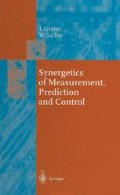Abstract
In the second chapter we mentioned that a natural law is usually expressed in terms of a relation between the variables used to characterize the state of Nature. We also pointed out that a natural law can be represented by a model formed by a mapping from the observed part of Nature to the properties of some device in such a way that the properties of Nature can later be retrieved from the model. In order to carry out a modeling automatically, the corresponding system, or the modeler, must include an array of sensors, a processor with a memory, such as an electronic computer, and an array of actuators. Our purpose here is to try to answer the previously-posed question: What are the general characteristics of an operating program that makes such a system into an automatic modeler of natural phenomena? To answer this question, we must first take into account the random character of physical variables and generalize the concept of a natural law. We then describe the fundamental operations of the system that are needed for the formation and application of natural laws.
Access this chapter
Tax calculation will be finalised at checkout
Purchases are for personal use only
Preview
Unable to display preview. Download preview PDF.
References
A. E. Albert, L. A. Gardner: Stochastic Approximation and Nonlinear Regression ( MIT Press, Cambridge, MA 1967 )
S. T. Alexander: Adaptive Signal Processing ( Springer, New York 1986 )
D. J. Bell: Mathematics of Linear and Nonlinear Systems, An Introduction for Engineers and Applied Scientists ( Clarendon Press, Oxford 1990 )
A. Dvoretzky: “On Stochastic Approximation”, Proc. 3rd Berkeley Symposium on Mathematical Statistics and Probability, Vol. 1, pp. 39–55, 1956
R. O. Duda, P. E. Hart: Pattern Classifìcation and Scene Analysis (John Wiley and Sons, New York 1973), Ch. 5
K. Fukunaga: Introduction to Statistical Pattern Recognition ( Academic Press, New York 1972 )
I. Grabec: “Self-Organization Based on the Second Maximum-Entropy Principle”, 1st IEE Conference on “Artificial Neural Networks”, London 1989, Conf. Publication No. 313, pp 12–16
I. Grabec: “Self-Organization of Neurons Described by the Maximum-Entropy Principle”, Biol. Cyb., 63, 403–409 (1990)
I. Grabec, W. Sachse: “Automatic Modeling of Physical Phenomena: Application to Ultrasonic Data”, J. Appl. Phys., 69 (9), 6233–6244 (1991)
S. Grossberg: “Nonlinear Neural Networks: Principles, Mechanisms, and Architectures”, Neural Networks, 1, 17–61 (1988)
H. Haken: Information and Self-Organization, A Macroscopic approach to Complex Systems, Springer Series in Synergetics ( Springer, Berlin 1988 )
S. Haykin: Adaptive Filter Theory ( Prentice-Hall Int., London 1991 )
R. Hecht-Nielsen: Neurocomputing ( Addison-Wesley, Reading, MA 1990 )
J. Kiefer, J. Wolfowitz: Stochastic Estimation of the Maximum of a Regression Function, Annals of the Mathematical Statistics, 23, 462–466 (1952)
D. E. Kirk: Optimal Control Theory; An Introduction ( Prentice-Hall, Englewood Cliffs, NJ 1970 )
T. Kohonen: “Self-Organized Formation of Topological Correct Feature Maps”, Biological Cybernetics, 43, 59–69 (1982)
T. Kohonen: An Introduction to Neural Computing, Neural Networks, 1, 3–16 (1988)
T. Kohonen: Self-Organization and Associative Memory ( Springer, Berlin 1989 )
G. A. Korn, T. M. Korn: Mathematical Handbook for Scientists and Engineers, Defìnitions Theorems and Formulas for Reference and Review (McGraw Hill, New York 1961, 1968 and later editions)
B. Kosko: Neural Networks and Fuzzy Systems, A Dynamical systems Approach to Machine Intelligence ( Prentice-Hall, Englewood Cliffs, NJ 1992 )
S. J. Orfandis: Optimum Signal Processing: An Introduction ( MacMillan, New York 1988 )
H. Robbins, S. Monro: A Stochastic Approximation Method, Annals of Mathematical Statistics, 22, 400–407 (1951)
D. E. Rumelhart, J. McClelland and The PDP Research Group: Parallel Distributed Processing ( MIT Press, Cambridge, MA 1986 )
G. N. Saridis: Stochastic Approximation Methods for Identifìcation and Control — A Survey, IEEE Transactions on Automatic Control, AC 19, 798–809 (1974)
R. J. Schalkoff: Pattern Recognition: Statistical, Structural and Neural Approaches ( John Wiley and Sons, New York 1992 )
Author information
Authors and Affiliations
Rights and permissions
Copyright information
© 1997 Springer-Verlag Berlin Heidelberg
About this chapter
Cite this chapter
Grabec, I., Sachse, W. (1997). Adaptive Modeling of Natural Laws. In: Synergetics of Measurement, Prediction and Control. Springer Series in Synergetics, vol 68. Springer, Berlin, Heidelberg. https://doi.org/10.1007/978-3-642-60336-5_7
Download citation
DOI: https://doi.org/10.1007/978-3-642-60336-5_7
Publisher Name: Springer, Berlin, Heidelberg
Print ISBN: 978-3-642-64359-0
Online ISBN: 978-3-642-60336-5
eBook Packages: Springer Book Archive

